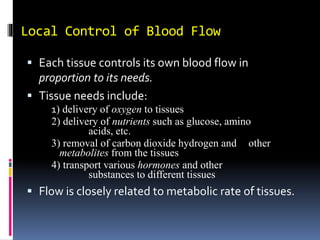
Lec59[1]
- 1. Local Control of Blood Flow Each tissue controls its own blood flow in proportion to its needs. Tissue needs include: 1) delivery of oxygen to tissues 2) delivery of nutrients such as glucose, amino acids, etc. 3) removal of carbon dioxide hydrogen and other metabolites from the tissues 4) transport various hormones and other substances to different tissues Flow is closely related to metabolic rate of tissues.
- 2. Variations in Tissue Blood Flow Brain 14 700 50 Heart 4 200 70 Bronchi 2 100 25 Kidneys 22 1100 360 Liver 27 1350 95 Portal (21) (1050) Arterial (6) (300) Muscle (inactive state) 15 750 4 Bone 5 250 3 Skin (cool weather) 6 300 3 Thyroid gland 1 50 160 Adrenal glands 0 .525 300 Other tissues 3.5 175 1.3 Total 100.0 5000 --- Percent ml/min ml/min/ 100 gm
- 3. Control of Blood Flow by Tissues Local control In most tissues, blood flow is proportional to metabolic needs of tissues Nervous System Most important for regulating blood flow and maintaining blood pressure Hormonal Control Sympathetic action potentials stimulate epinephrine and norepinephrine
- 4. Tissue Metabolic Activity Is the Main Factor in Acute Control of Local Blood Flow One of the most fundamental principles of circulatory function is the ability of each tissue to control its own local blood flow in proportion to its metabolic needs Metabolic Mechanism Any intervention that results in an inadequate oxygen (nutrient) supply for the metabolic requirements of the tissues results in the formation of vasodilator substances which increase blood flow to the tissues.
- 5. Acute Control of Local Blood Flow Increases in tissue metabolism lead to increases in blood flow. Decreases in oxygen availability to tissues increases tissue blood flow. Two major theories for local blood flow are: 1) The vasodilator theory 2) Oxygen demand theory
- 6. Effect ofTissue Metabolic Rate onTissue Blood Flow
- 7. Effect of Tissue Oxygen Concentration on Blood Flow
- 8. Acute Local Feedback Control of Blood Flow Lack of oxygen? Formation of vasodilators? Combination of both?? Metarteriole Precapillary Sphincter Capillary Relaxation of smooth muscle Increased Blood Flow
- 10. Metabolic Mechanisms Hypoxia Tissue metabolites and ions Adenosine Potassium ions Carbon dioxide Hydrogen ion Lactic acid
- 11. Metabolic Control of Local Blood Flow
- 12. Autoregulation of blood flow when arterial pressure changes from normal Intrinsic ability of an organ to maintain a constant blood flow despite changes in pressure Possible explanations for Autoregulation: Myogenic Mechanism Metabolic Mechanism
- 13. Theories to Explain Autoregulation: Metabolic Mechanism When the pressure increases to a tissue, the flow increases, and excess oxygen and nutrients are provided to the tissues. These excess nutrients cause the blood vessels to constrict and the flow to return nearly to normal despite the increased pressure.
- 14. Theories to Explain Autoregulation: Myogenic Mechanism When the lumen of a blood vessel is suddenly expanded, the smooth muscles respond by contracting in order to restore the vessel diameter and resistance. The converse is also true. Vascular smooth muscle cells depolarize when stretched. Proposed mechanism is stretch of vascular smooth muscle causes activation of membrane calcium channels.
- 15. Theories to Explain Autoregulation: Myogenic Mechanism P1 F1 ↑P ↑F ↑P F1
- 16. Long-term Regulation of Blood Flow Long-term regulatory mechanisms which control blood flow are more effective than acute mechanism Long-term local blood flow regulation occurs by changing the degree of vascularity of tissues (size and number of vessels) Oxygen is an important stimulus for regulating tissue vascularity
- 17. Short and long term Regulation of Blood Flow
- 18. Angiogenesis Angiogenesis is the growth of new blood vessels Angiogenesis occurs in response to angiogenic factors released from: 1) ischemic tissue 2) rapidly growing tissue 3) tissue with high metabolic rates Most angiogenic factors are small peptides such as vascular endothelial cell growth factors (VEGF), fibroblast growth factor (FGF), and angiogenin
- 19. vascular endothelial growth factor (VEGF)
- 20. The endothelium plays an active role in regulating blood flow Endothelium is a source of substances that elicit contraction or relaxation of the vascular smooth muscle Vasoactive substances released from endothelium: Nitric Oxide (NO) Endothelium-derived relaxing factor Prostacyclin Endothelin
- 21. Control of blood flow from endothelial cells Originally called Endothelium-derived relaxing factor (EDRF), which is now identified as nitric oxide Rapid flow of blood through the arteries and arterioles causes significant increase in the release of nitric oxide The nitric oxide relaxes the blood vessels
- 22. L-Arginine is converted to NO by the enzyme nitric oxide synthase (NOS)
- 23. Prostacyclin Prostacyclin (PGI2) Strong vasodilator Inhibits platelet adhesion to the vascular endothelium
- 24. Endothelin Potent vasoconstrictor Increased aldosterone secretion Decreased renal blood flow and GFR
- 25. When Damage to Endothelium Occurs Damage to endothelial cells will lead to: Decreased Nitric Oxide and Prostacyclin production Increased Endothelin production This will lead to: Vasoconstriction Vasospasm Thrombosis
